
How to Build a Savings Pipeline for SaaS Renewals
Table of Contents ToggleWhat Is a SaaS Savings Pipeline?Why Managing SaaS...
Back
Back
Search for Keywords...
Blog

Table of Contents
In 2025, the average large enterprise (10k+ employees) spends $284M on SaaS, yet they waste more than $127M annually on unused licenses alone. Effective enterprise software management is needed to control costs, ensure compliance, and maintain efficiency.
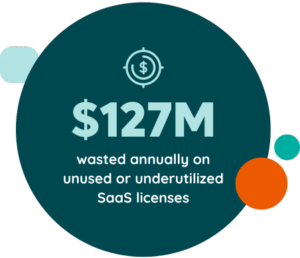
Management has grown more complex with the surge of applications and decentralized IT. Organizations need structured processes and tools to track usage and optimize spending. Without them, businesses face wasted resources, redundant applications, and lost efficiency.
In this article, we’ll:
Enterprise software management refers to the process of overseeing an organization’s software applications. This includes:
Effective enterprise software management:
Another way to think of enterprise software management is as a lifecycle, with procurement, deployment, adoption, optimization, and retirement. Each stage needs governance to ensure that costs remain in check and that tools deliver measurable value to the business. Companies that fail to manage these stages properly often find themselves overpaying for software that doesn’t align with overall business goals.
Enterprise software management is important because it addresses these common pain points:
Managing software at the enterprise level goes beyond controlling SaaS costs. It is crucial to ensure business operations are progressing efficiently, employees remain productive, and risks are carefully considered. Enterprise companies face unique challenges in this task due to the scale of applications in use and the decentralized nature of software adoption.
In addition, enterprise software management helps IT leaders provide actionable insights to executives. Doing so improves resource allocation and strengthens overall IT governance throughout the organization.
On top of cost savings and compliance, effective management also enhances employee experience. Streamlined access to the right tools means workers spend less time hunting for software or toggling between platforms. This efficiency directly impacts productivity, morale, and even employee retention, especially in large enterprises where digital friction can be a major pain point.
Without centralized visibility, enterprise IT teams may not know:
Visibility gaps typically result in redundant software purchases, security issues, and improper license management. In contrast, when visibility is centralized, it:
Zylo’s 2025 report shows that the average enterprise sees 12 new apps enter its environment each month—a 22% annual portfolio growth rate. These quickly-growing portfolios are due to shadow IT purchases and contribute to SaaS sprawl.
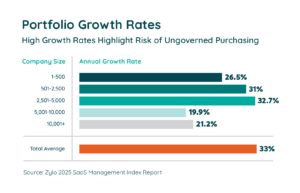
As a result, IT and security experience blind spots that:
Employees buy software on credit cards to solve immediate needs, but they often bypass official procurement processes. What looks like a low-cost subscription can cost more if it leads to a data leak or conflicts with enterprise-wide systems.
Redundant applications represent a major source of wasted spend. Rationalizing the top three redundant app functions (online training classes, project management, and team collaboration) can yield a savings opportunity of $44,000 to $722,000 per year.
Discovering and highlighting tool overlap requires understanding each application’s usage patterns and its role in business processes. Periodic software rationalization exercises can also identify redundancies and empower enterprises to consolidate similar tools and negotiate better contracts.

Gartner estimates that, through 2027, organizations without centralized visibility will overspend by at least 25%. Overspending on enterprise software often results from:
Enterprises waste millions from unused and underutilized SaaS licenses. That is money you could otherwise direct toward growth initiatives and innovation projects.
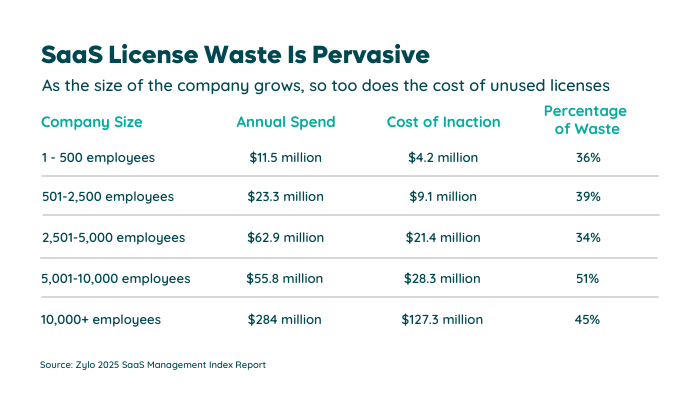
Enterprises have an average of 476 renewals per year, approximately two per business day. Without proper management, organizations risk missing renewal deadlines, which can result in:
Only a fraction of renewals are actively managed in most enterprises, highlighting the importance of consistent renewal tracking and proactive planning.
In addition to cost concerns, unmanaged software exposes enterprises to compliance and security risks. Almost 60% of applications in the average enterprise SaaS portfolio have a low or poor risk score.
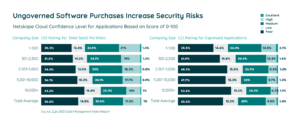
The most common types of enterprise software include:
Enterprise software includes several categories, each of which is essential for operations and business growth. Being aware of the types of tools in use helps IT professionals reduce redundancies and get the most value possible from software purchases. Proper categorization also enables accurate reporting and identification of gaps in functionality.
Enterprise Resource Planning (ERP) systems organize core business processes, including finance, supply chain, and operations. Examples include programs like SAP, Oracle, and Microsoft Dynamics. ERPs help organizations maintain accurate records, streamline business processes, and enhance decision-making. These systems also enable consistent data access across departments to improve forecasting and planning.
Customer Relationship Management (CRM) software helps enterprises manage the many interactions that take place with clients and prospects. CRMs support sales automation, marketing campaigns, and customer service efforts. When well-managed, a CRM system makes it easier for businesses to personalize customer engagement, which (ideally) leads to revenue growth.
Business Intelligence tools (like Power BI and Tableau) analyze data to make decision-making more strategic. These tools turn raw data into reports that present actionable insights on financial forecasting, market analysis, and operational efficiency. Enterprises benefit from visual dashboards that consolidate data from several sources to improve cross-departmental collaboration.
Human Resources software like Workday and ADP manage employee information, payroll, recruiting, and performance. Well-rounded HR systems improve productivity, compliance, and employee experience. HR tools also simplify talent management strategies and succession planning across large organizations.
Effective enterprise software management depends on several components, each of which contribute to cost control, risk reduction, and business efficiency.
Discovery showcases all applications a business uses, including shadow IT. Tools like Zylo’s Discovery Engine offer full visibility into software environments to enable informed decision-making on spend and governance. As new apps enter the enterprise environment, continuous discovery helps ensure they are accounted for.
Cost control involves tracking license usage, eliminating redundant software, and optimizing contracts. Accurate cost visibility helps ensure organizations allocate resources properly and avoid unnecessary expenditures. Regular cost analyses and spend dashboards help executives make data-informed budgeting decisions.
Governance policies standardize software adoption processes, enforce compliance, and help avoid risks. Effective governance procedures ensure licensing obligations are met, and protects organizations from preventable legal or financial consequences.
Security oversight highlights system vulnerabilities, reduces an organization’s exposure to cyber threats, and protects sensitive enterprise data. Regular risk assessments and integration with up-to-date security tools help maintain a strong security posture. Security monitoring should also include evaluating third-party integrations and API connections.
Enterprises face several challenges in managing extensive software portfolios. Addressing these challenges takes both strategy and the right tools.
Addressing and reducing sprawl calls for both automated discovery and thorough governance policies. Organizations need to:
Organizations can reduce license waste through:
To prevent waste, regular audits and automated license tracking is essential. Organizations that implement license reclamation processes and assign accountability to department heads to enhance utilization efforts.
To make these processes easier, use a SaaS Management Platform. It can automatically flag unused or underused licenses and recommend appropriate optimization strategies. In addition, implementing chargeback or showback models can incentivize departments to manage licenses more responsibly.
Implementing renewal tracking ensures that contracts are reviewed before they expire. Alerts and dashboards from SaaS Management tools enable IT and procurement teams to manage hundreds of renewals efficiently. Centralized renewal calendars and cross-team coordination can also prevent lapses and optimize contract negotiations.

Security risks should be mitigated through:
Implement an enterprise software management program to monitor risk profiles, enforce compliance policies, and secure sensitive data. Regular compliance and security checks, integration with security tools, and risk scoring help ensure that all enterprise applications adhere to internal and external standards.
Implementing a SaaS Management program includes the following components.
A phased approach to SaaS Management ensures that discovery, optimization, and governance efforts are sustainable and scalable across the enterprise. It allows IT professionals to focus on high-impact areas and yield measurable results early in the implementation process.
To ensure all aspects of software management are addressed and reach your desired results, a framework is the first essential step. For instance, Zylo’s SaaS Management Framework guides enterprises through discovery, optimization, governance, and monitoring. It encourages collaboration between IT, finance, and procurement teams to pair software usage with strategic business objectives.
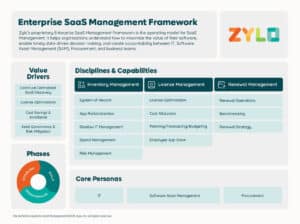
This framework unfolds in phases that match organizational maturity and capacity:
The Definitive Guide to SaaS Management
Learn MoreAutomated tools like an SMP help businesses streamline monitoring, license management, renewals, and governance. Integrating a platform into your existing IT workflows also reduces manual effort and enhances data accuracy. Automation helps enterprises respond quickly to emerging risks or changes in usage patterns to ensure ongoing optimization.
Executive sponsorship ensures your program receives the resources and authority it needs to generate success. Aligned leadership helps improve adoption across departments and enforces compliance. Routinely updating executives on key metrics and savings numbers reinforces the program’s value and encourages sustained support.
Defining clear objectives for the SaaS Management program aligns the IT team’s initiatives with the organization’s priorities. Metrics and KPIs help illustrate measurable outcomes for software investments. By establishing success criteria early, teams can focus more on areas that deliver the most business value.
Partnering with a software management provider (like Zylo) offers expertise, benchmarking, and advanced analytics to optimize software portfolios and their governance. A strategic partner can provide effective guidance on best practices, compliance standards, and emerging trends in enterprise software management.
Following industry best practices helps ensure ongoing efficiency, cost control, and risk management. These practices enable long-term sustainability and aid organizations in scaling software management efforts effectively.
Continuously monitoring software usage and cost helps enterprises identify inefficiencies and prevent wasteful spending. Real-time dashboards and automated reports support more proactive decision-making as well. This sort of ongoing vigilance allows IT teams to react quickly to changes in adoption, contract issues, or compliance concerns.
When you have a single view of all your organization’s applications, it ensures informed decision-making and efficient license management. Maintaining centralized visibility also enables IT teams to detect underutilized applications, optimize subscriptions, and reduce redundancy across departments.
Tracking utilization patterns, reclaiming unused licenses, and optimizing contracts ensures cost efficiency. Periodic audits and automated notifications help maintain clear alignment between software usage and procurement policies.
Preparing for renewals well in advance prevents missed deadlines, interruptions in service, and unfavorable contract terms. Integrating renewal planning into annual budgeting cycles provides both financial predictability and possible negotiation leverage.
Selecting the right tools is fundamental for enterprise software management. A well-rounded suite of tools enhances operational visibility, governance efforts, and cost efficiency in addition to minimizing manual demands.
Additional enterprise software management tools support broader operational needs, such as:
Other supporting tools include analytics dashboards, compliance tracking platforms, and automated reporting systems that integrate across multiple software categories.
Selecting a tool requires evaluating:
Additionally, consider ease of use, vendor support, and the ability to customize workflows. Pilot programs and phased rollouts can help confirm tool effectiveness before full deployment.
Integration ensures seamless data flow between IT, finance, and business operations. Proper integration improves visibility, reduces manual workloads, and enables more data-supported decision-making. Integrated systems reduce duplicate data entry, improve reporting accuracy, and create a holistic view of enterprise software utilization.
Emerging trends in enterprise software for 2025 include:
The enterprise software landscape, like many technical industries, is continuing to evolve at a rapid rate. As this complexity grows, organizations face risks like overspending, security gaps, and inefficient software usage, which highlights the importance of enterprise software management.
Instead of reacting to changes after they’ve reshaped the industry, forward-thinking leaders can invest in the right tools, adjust governance models, and prepare for emerging risks before they become costly problems.
Organizations that anticipate upcoming trends can better optimize their adoption strategies, reduce risks, and improve ROI better than the competition. Looking at where enterprise software is headed provides valuable foresight for IT leaders. The following trends represent key areas to watch:
Artificial intelligence is transforming enterprise software by streamlining discovery, usage analysis, and predictive license optimization. By detecting adoption patterns, predicting license needs, and automating compliance, AI enhances operational efficiency and supports more strategic decision-making across large software portfolios.
Cloud adoption brings with it flexibility, scalability, and cost advantages. Enterprises using cloud-first strategies can scale services quickly, reduce infrastructure overhead, and maintain their agility, while clear visibility and governance ensure usage and spending remain optimized.
Open source software offers cost savings and innovation opportunities. Tracking usage, maintaining security standards, and ensuring licensing compliance help organizations safely leverage community-driven solutions while mitigating intellectual property and operational risks.
Consumption-based pricing aligns costs with actual usage, which encourages efficiency and financial flexibility. Monitoring usage patterns and spend helps organizations optimize investment in software services while avoiding surprises in subscription or consumption costs.
While future trends promise efficiency and cost alignment, they also introduce complexity to enterprise software management. Zylo was purpose-built to help enterprises stay ahead by providing ongoing visibility, analytics, and governance needed to adapt quickly.
Companies like AbbVie, Adobe, Atlassian, Intuit, Salesforce, and Yahoo trust Zylo to drive their business outcomes. Learn more about the platform, and schedule time with our team of experts for a deep dive.

Table of Contents ToggleWhat Is a SaaS Savings Pipeline?Why Managing SaaS...

Table of Contents ToggleWhat FinOps Means in the Modern Cloud EnvironmentWhy...

Table of Contents ToggleWhat Is Enterprise Software Management?The Importance of Enterprise Software...

Table of Contents ToggleWhat Is Enterprise Software Management?The Importance of Enterprise Software...
| Cookie | Duration | Description |
|---|---|---|
| cookielawinfo-checkbox-analytics | 11 months | This cookie is set by GDPR Cookie Consent plugin. The cookie is used to store the user consent for the cookies in the category "Analytics". |
| cookielawinfo-checkbox-functional | 11 months | The cookie is set by GDPR cookie consent to record the user consent for the cookies in the category "Functional". |
| cookielawinfo-checkbox-necessary | 11 months | This cookie is set by GDPR Cookie Consent plugin. The cookies is used to store the user consent for the cookies in the category "Necessary". |
| cookielawinfo-checkbox-others | 11 months | This cookie is set by GDPR Cookie Consent plugin. The cookie is used to store the user consent for the cookies in the category "Other. |
| cookielawinfo-checkbox-performance | 11 months | This cookie is set by GDPR Cookie Consent plugin. The cookie is used to store the user consent for the cookies in the category "Performance". |
| viewed_cookie_policy | 11 months | The cookie is set by the GDPR Cookie Consent plugin and is used to store whether or not user has consented to the use of cookies. It does not store any personal data. |
